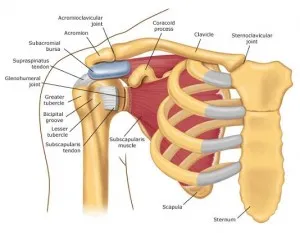Have you ever wondered why your shoulder pops?
I get this question quite a lot. There are several reasons for this very common issue. Unlike the hip where the socket is deep, in the shoulder the its very shallow, more of a slightly concave surface. Because of this layout the shoulder is a complex and inherently “unstable” joint meaning that without the muscles and ligaments it would completely dislocate. While this gives us a lot of motion to do thinks like throw it comes with a price.
It is comprised of bone, ligaments, cartilage, and tendons that allow for the ease of movement in so many different directions. This is also why the shoulder is a commonly injured joint that results in pain.
Before assuming the worst, ask yourself…
- Is the popping painful?
- Has there been a recent injury of the shoulder resulting in any shoulder pain?
- Does my shoulder feel stable?
- Is it accompanied by any weakness?
Clicking and popping may occur for many reasons. If it is painless, it can be just a harmless joint noise known as crepitus. But if it is associated with pain it may be due to soft tissue damage or degenerative arthritis from years of wear and tear. This occurs when the cartilage that protects the bone has worn down and is now rough. The joint is no longer smooth and increased friction can develop making the joint rub together like two pieces of sand paper. The result is increased joint inflammation and shoulder pain. If left untreated, it can continue to progress causing loss of motion, strength, and eventually inability to use the arm.
Sometimes clicking and popping can be due to repetitive over use of the shoulder resulting in bursitis and tendinitis. These conditions occur from too much of the same activity that causes swelling in bursa and rotator cuff tendons. The bursae are fluid filled sacs that cushions the shoulder. The tendons are the cords that connect the muscle to the bone. The rotator cuff tendons become worn down slowly over time much like the sole of a shoe that eventually wears apart. If left untreated, the result is a tearing of the rotator cuff tendon causing increased pain, inability to sleep, lost motion, decreased strength, and inability to use the arm with many daily activities.

Shoulder pain and impingement occurs when the space between the top of the shoulder blade (called the acromion) and the top of the upper arm bone (called the head of the humerus) is narrowed due to swelling and inflammation. This causes a pinching of the rotator cuff tendons and bursa. If left untreated, this too can lead to fraying or tearing of the rotator cuff tendons and lost function in the shoulder.
Shoulder instability occurs when the head of the upper arm bone (humerus) moves too much in relation to the socket. In many cases, the ligaments which hold the bones together are too loose. This laxity can be genetic or traumatic in origin. The result is additional damage to the cartilage (labrum) of the shoulder and increased pain and weakness. If left untreated, the episodes can increase in severity and frequency. This can cause increase your risk of developing arthritis.
Treatment of Shoulder Pain & Popping

One of our licensed physical therapists will perform an initial examination to identify the cause of the pain. At Synergy Physical Therapy and Wellness, one of our main goals is teaching our patients with shoulder pain how to address the issue to find a permanent solution whenever possible. Several tests are performed to identify the problematic areas in strength, flexibility, and muscle function.
- Protection of the shoulder can be necessary to prevent further damage. This may include rest for a period of time and education about activities and movements to avoid.
- Flexibility activities to increase mobility without pain or discomfort are included. These should be gentle and progressive with emphasis on proper mechanics of the shoulder.
- Progressive strengthening exercises for different muscle groups. Examples include specific rotator cuff exercises and shoulder blade strengthening (known as scapular stabilization).
- Advanced techniques such as massage, mobilizations, manual therapy under the expert supervision of the physical therapist can be effective ways to decrease shoulder pain.
In addition to the above treatments, Synergy Physical Therapy & Wellness and Wellness utilizes Microcurrent Point Stimulation and the ML830 Cold Laser.
Microcurrent Point Stimulation is a highly effective tool to relieve pain. It uses very low levels of therapeutic energy applied to specific points in the body to instantly relief pain. This is the complete opposite of “TENS” which in my experience only results in very short term pan relief if any relief at all. This is important because effective pain relief makes everything else we do such as movements, hands on therapy and stretching, much easier and effective. CLICK HERE TO LEARN MORE
The 830Laser uses light energy to decrease pain, decrease inflammation and increase tissue healing. This treatment does not wear off like heat, ice, or medications. If you don’t re-injure the area, the pain should not return. Our clinic.
The first step is to educate you in methods to help yourself through activity modification and joint protection followed by exercises and hands on techniques to permanently alleviate your pain. We are experts in how to deal with shoulder pain and popping. This is a problem we deal with on a regular basis with a very high success rate.
At Synergy Physical Therapy & Wellness and Wellness, we are committed to helping you live a healthy and pain free life. We always work closely with your physician and insurance company to make sure you have the best care available. Be wary of other physical therapy clinics who use treatments such as heat, ice, and ultrasound as these treatments do not address the root cause of the shoulder pain and problem and wear off.
